 “The dragons are coming! The dragons are coming!” The shout echoed throughout the valley, startling all dwarves within earshot, causing some even to spill their coveted mugs of beer. A party foul most certain. A massive shadow passed overhead. There was nowhere left to run. The vacation away from the tunnels with their deadly cave-ins was at an end. Fortunately, there was still a place to hide. The caverns beneath the mountain were now their only hope of survival.
“The dragons are coming! The dragons are coming!” The shout echoed throughout the valley, startling all dwarves within earshot, causing some even to spill their coveted mugs of beer. A party foul most certain. A massive shadow passed overhead. There was nowhere left to run. The vacation away from the tunnels with their deadly cave-ins was at an end. Fortunately, there was still a place to hide. The caverns beneath the mountain were now their only hope of survival.
Brought to you by Atlas Games and designed by Joshua DeBonis and Nikola Risteski, Dice Miner is all about securing the correct allotment of dice as you mine three mountains. It features drafting and rolling and plays one to four players in approximately twenty to thirty minutes.
Gameplay Overview:
Dice Miner spans three rounds. At setup, each player receives a hero card with a unique power. A sloped mountain board is randomly filled with dice drawn (or poured) from a dice bag. This presents the area where players draft dice into their tableau, called the trove. The first player drafts one die from the top of the mountain and a round continues clockwise until all dice are drafted.
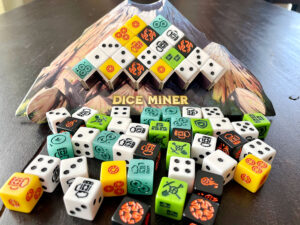
There are five different types of dice in the game, each featuring one side with a beer on it (more on this icon later):
- The white tunnel dice are numbered one to five and must be grouped sequentially. Players score sequences that begin with the number one. For example, a sequence that features a one, two, and four dice only score for the one and two dice since a three is missing in the sequence.
- The black hazard dice feature cave-in or dragon icons that must be combated. They score negative points per icon if left unchecked, positive points otherwise.
- The green tool dice feature pickaxes and shields to combat the hazards, as well as treasure chests used to cache dice between rounds.
- Yellow treasure dice feature one to three gem icons. Each gem scores a point and the player with the most gems each round doubles their total gem value.
- Teal magic dice feature one to three reroll icons.
After all dice are drafted, players use any magic dice to reroll their choice of die, outside of the hazard dice which cannot be changed. They then score their trove. Next, players reroll all dice in their trove not cached and replenish the mountain for the next round.
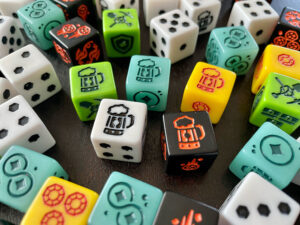
The beer icon is special. If in a player’s trove, beer icons allow players to say “Cheers!” and choose a player to receive this dice after it is rerolled. Then the player who said “Cheers!” gets to choose two dice from either the top (as normal) or the sides of the mountain. The player who received the rerolled beer die adds it to their trove.
Beyond the two to four player alternating game, Dice Miner also includes a solo mode that features restrictions on drafting and scoring. It is a beat-your-score system that lasts ten to fifteen minutes per game.
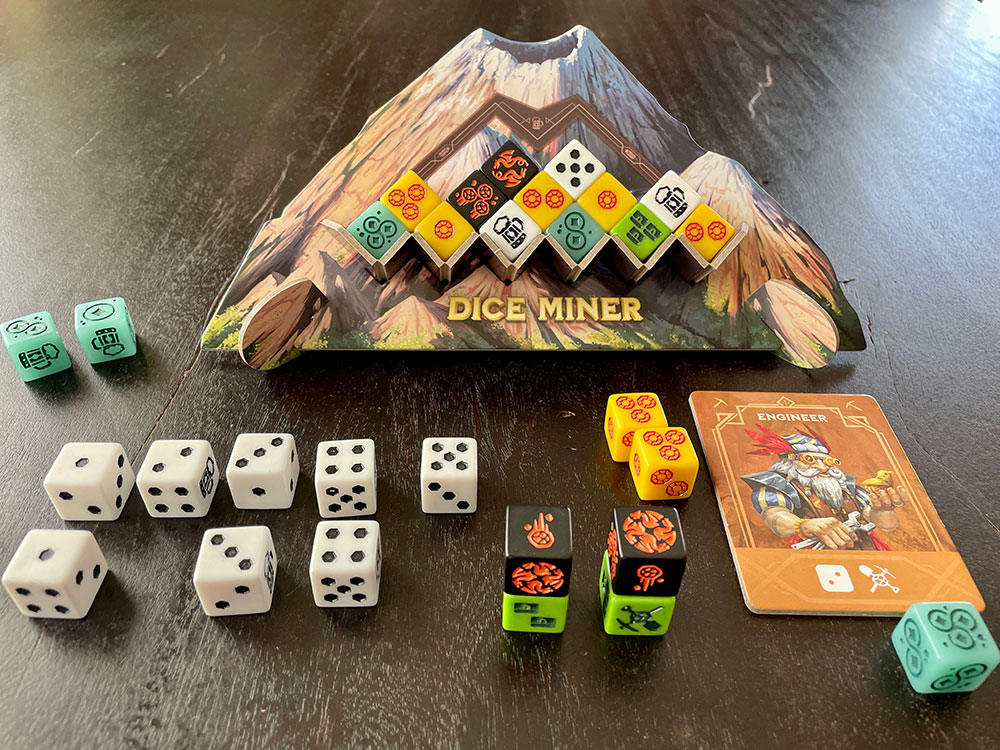
Game Experience:
Dice Miner has a couple things going for it. The first is the components, specifically the quality dice with clear iconography and easy to discern color arrangement. The sloped mountain board and hero cards are also made with thick cardboard and will stand the test of time. The board is easy to fill and clearly showcases the available options each round.
Another positive for Dice Miner is the beer mechanism. Drafting a beer can feel like a wasted turn, exposing new dice for another player to take, but it opens a little strategy in the game by giving you a chance to take two dice later. It also creates an interactive space by sending a die to another player that may benefit their operation. The only trouble with the beer dice is that the mountain board only features twenty dice each round, so beer is more valuable near the top as it allows players access to side dice options before everything is depleted.
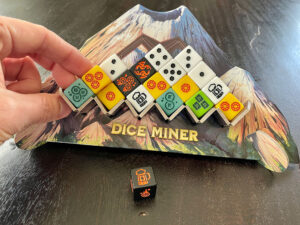
Player count, however, is a mixed bag. Considering every game has the same number of dice, playing with fewer people (two-player) means you have more dice to use. But the drafting isn’t as engaging. At higher player counts drafting is more interactive (your beer options also improve), but you have fewer dice to work with. Scaling is limited by the mountain’s design and not providing scaling in other ways is a design misstep.
While the theme is pasted on, the narrative does enough to engage the round-to-round purpose of drafting. You’re clearing out the mountain for the dwarves to live in. But beyond that idea, everything else included plays in a more abstract manner. Plus, no reason is given for why you reroll your dice between rounds outside of presenting a new challenge. I like to think of it as an earthquake caused by the constant mining operation, but even that is a departure from the rulebook’s story about dragons that have returned.
And finally, the looming negative: luck. Dice Miner is draped in luck. The final scores in the game swing wildly in either direction with very little to mitigate them. Not only is the mountain board filled randomly, making the draft potentially benefit one player over another, but the mid-round re-roll also wildly changes player’s troves. The only reliable “mitigation” comes in the form of the magic dice, allowing multiple rerolls and a chance to secure a much-needed icon. If that happens. Thankfully games are quick so those wanting to jump back in can press their luck again.
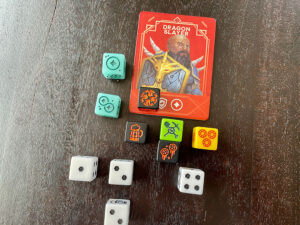
The solo mode is another example of luck overtaking the fun. Due to restrictions on which dice can be selected in this mode, players can find themselves without viable choices before having to refill the mountain board. And in the solo game, the board can only be filled three times before it is over. Everything hinges on the proper combination of dice to reach the highest scores. When you’re relying that heavily on randomization, frustration can set in fast.
Beyond the game modes, one final area of note is the hero cards. Each hero features unique dice icons that are considered “virtual” and can prove very valuable. It’s a shame that only six of these hero cards are included in the base game. A backer kit for the game comes with six additional heroes, so there are more out there to find, but it’s shame they didn’t make it into the retail game to improve variability and offer a little more replay value.
Final Thoughts:
In the end, Dice Miner is for those looking for fast play and swingy results. There’s plenty of push-your-luck and tableau-building opportunities in store, but ultimately these are rather chaotic. I can’t tell you how many times I rerolled a single die to watch it land on a face that gave me either no points or pushed me into the negative. Then I’d watch my opponents roll their desired option, increasing their score by a large margin. As such, this is not for players that prefer a little strategy with their drafting titles. Add to the luck factor a lack of additional variability and Dice Miner doesn’t seem to have enough going for it to carve a space on the table regularly.
Final Score: 2 stars – Suitable for those brave souls who enjoy a large mug of luck with their dice games, Dice Miner doesn’t do enough to shine like a gem in your collection.
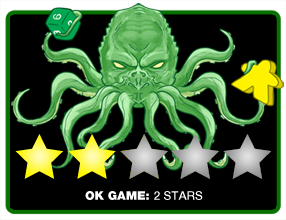 Hits:
Hits:
• Quality dice and components
• Sharing beer
Misses:
• Luck-based gameplay
• Lack of variety
• Frustrating dice drafting





















